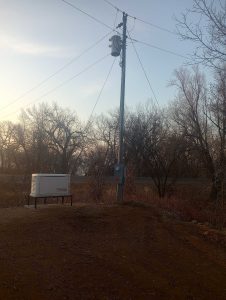Here are the top three reasons – Money, Availability, and Recycling/Reusing.
Trying to save a few bucks on your pole barn and don’t care about longevity or ease of use, then used utility poles may be the answer. Most people, who are going to invest an average of $50,000 into a new building, prefer to have a design solution which can be relied upon however.
As discussed in my recent articles, most utility poles are replaced due to decay issues. Oil based preservative treatments (like penta or creosote) are affected by time and gravity. As the treatment chemicals wear thin at the ground line, decay begins to occur and the utility company replaces the pole. In an attempt to reuse the poles, the portion which was at the former ground line (the decay zone) should be cutoff and properly disposed of in a landfill. This leaves the remainder of the pole being the portion with little or no treatment chemical remaining.
If one of these poles happens to rot in a new pole barn, the cost to replace it will be more than what was initially “saved”, even if the poles were free.
 Building a pole building which requires a structural review of the plans? (In my humble opinion, all plans should be so reviewed.) Building officials are probably not going to “buy in” to the use of used utility poles. Why? There is no way to determine if what remains will meet with the minimum code requirements for preservative treatment.
Building a pole building which requires a structural review of the plans? (In my humble opinion, all plans should be so reviewed.) Building officials are probably not going to “buy in” to the use of used utility poles. Why? There is no way to determine if what remains will meet with the minimum code requirements for preservative treatment.
Fully enclosed building? Many will find the odors of oil based chemicals to be an issue, not to mention having the chemicals continuing to leech from the posts. Even the CCA (Chromated Copper Arsenate) treated pole can no longer be used in residential applications due to EPA (Environment Protection Agency) regulations.
Ease of use – used utility poles are round and tapered. In order to place them in a building so dimensional lumber can be properly affixed, the sides of the pole which will be attached to, are best cut to a flat surface. Besides complexity, this also adds the issues of hazardous chemicals being placed into the air, both as fumes and in the sawdust. Dealing with the taper, means the poles will not be set plumb, in relationship to the actual center of the pole, but will instead be leaning outward, so the outside face is vertical. This may be less of an issue, unless an interior finish of some sort is to be added at a later date.
Many utility companies have used poles laying around – they are not easily disposed of, as they should be taken to a landfill and buried as hazardous waste. This makes the utilities all too happy to either give them away, or to sell them at what seems to be a bargain.
And, while I am all for recycling and reusing, this is just one place where it does not make sense from a practical or economic standpoint.






